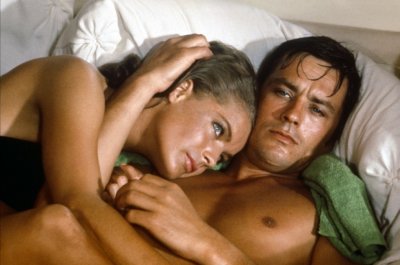Reviews - La Piscine
La Piscine
Reviewed By John Stakes

La Piscine
It was back to France again last Sunday, a long way back in fact, as we revisited one of the “coolest” French films of the sixties, Jacques Deray’s 1968 film drama “The Swimming Pool” starring French heartthrob Alain Delon and his former partner of five years the sultry Romy Schneider.
The “cool” French cinema of the late sixties spawned some memorable films including the French-Italian co-production “Barbarella” from director Roger Vadim, Claude Chabrol’s “Les Biches”, Truffaut’s “The Bride Wore Black”, Girl on a Motorcycle”, and Jean-Luc Goddard’s “Week-End” to name but a few in a busy 1968. The “coolest” of politicians Pierre Trudeau had just become Canada’s PM and, back in France, when it was “cool” to be young, the country was just recovering from the Paris student riots. So what is a “cool” film and why was Deray’s film so successful?
In film-making terms French “cool” often meant the characters were rich, bored but beautiful people, invariably heavy smokers, living detached lives in wonderful locations and hiding their emotions usually behind dark glasses. In Delon’s case his sunglasses became his trade-mark. Hearts were never worn on sleeves. The Gallic air was heavy with the atmosphere of sexual tension and infidelity which was usually merely hinted at but never graphically portrayed so maintaining the aura of detachment. Young children, naturally demanding and diverting, rarely figured in the screenplays as they would have inevitably muddied the self-obsessed waters of the preening adults.
The story involves Jean-Paul (Delon), and his girlfriend of two years Marianne (Schneider) into whose swimming pool villa world enter Harry (Maurice Ronet) an old friend of both and Marianne’s former lover. Harry’s daughter Penelope (Jane Birkin) completes the foursome and the game of emotional chess is underway. Harry draws Marianne back to him and Jean-Paul and Penelope move closer to each other. The tensions eventually spill over and Harry is drowned by Jean-Paul who claims accidental death. The police are called and suspect foul play but after confessing to Marianne, Jean-Paul finds she becomes his ally as she covers up incriminating evidence. At the film’s conclusion Marianne is on the point of leaving Jean-Paul but he persuades her (for how long?) to stay.
The intriguing question whenever journeying back into the archives is whether a film can stand the test of time. Its failure does not necessarily devalue its significance because most films belong to their era and the pace of life, public attitudes and tastes invariably change. The narrower but crucial question for “The Swimming Pool” is whether it has lost its sexual intrigue and possessive potency which, for all its detached air, was fundamental to the film’s drive. And the advantage of lengthy perspective is that it allows us more coolly to analyse the film’s strengths and weaknesses.
For its time the depiction of the film’s adult theme and occasional semi-nudity would have been considered avant-garde. Now time-stripped of its shock value what was left? For this reviewer there proved precious little to applaud. It may have reflected the truth of the lives of these others (so that we were meant to feel their boredom) but the acting was lacklustre, with no-one managing to create much in the way of sexual tension. Schneider successfully brought Barbie to the big screen. Jane Birkin’s facial expressions never complemented her occasional dialogue. Each character was devoid of any personality or depth. The emotional sterility of their lives was matched by the banality and tedium of the script which gave them nothing of any interest to say in over two hours. “Is it hot out there” was endlessly repeated. Making allowances for the deliberately gentler pacing, the direction was still as pedestrian as the narrative development. Where were Jean-Louis Trintignant, Simone Signouret, Stephane Audran, and Jeanne Moreau to inject some semblance of humanity and intrigue into this insipid tale?
At least the sun shone relentlessly in France for the second week in succession and, contrary to this reviewer’s personal take on this late example of French “nouvelle vague” cinema, many of the large audience very much enjoyed their second Gallic experience in eight days.
Delon, then 33, and described as “the male Brigit Bardot” (!) was hugely popular at the time (he made four films in 1968 alone), and went on to star in one of France’s most successful films “Borsalino” and later to feature as the masked Zorro in 1975. He made his latest film in 2008 “Asterix at the Olympic Games” and still lives in Geneva. Having split from Delon in 1963 Romy Schneider and Delon remained friends. She married German director Harry Mayen in 1964 and had a son David. Tragedy followed when Mayen committed suicide and David died in an accidental fall when age 14. Schneider turned to alcohol and died of a heart attack in her Paris apartment 1982. She is survived by a daughter Sarah (who is also an actress) to her marriage to Daniel Biasini, her private secretary, in 1975.
The “cool” French cinema of the late sixties spawned some memorable films including the French-Italian co-production “Barbarella” from director Roger Vadim, Claude Chabrol’s “Les Biches”, Truffaut’s “The Bride Wore Black”, Girl on a Motorcycle”, and Jean-Luc Goddard’s “Week-End” to name but a few in a busy 1968. The “coolest” of politicians Pierre Trudeau had just become Canada’s PM and, back in France, when it was “cool” to be young, the country was just recovering from the Paris student riots. So what is a “cool” film and why was Deray’s film so successful?
In film-making terms French “cool” often meant the characters were rich, bored but beautiful people, invariably heavy smokers, living detached lives in wonderful locations and hiding their emotions usually behind dark glasses. In Delon’s case his sunglasses became his trade-mark. Hearts were never worn on sleeves. The Gallic air was heavy with the atmosphere of sexual tension and infidelity which was usually merely hinted at but never graphically portrayed so maintaining the aura of detachment. Young children, naturally demanding and diverting, rarely figured in the screenplays as they would have inevitably muddied the self-obsessed waters of the preening adults.
The story involves Jean-Paul (Delon), and his girlfriend of two years Marianne (Schneider) into whose swimming pool villa world enter Harry (Maurice Ronet) an old friend of both and Marianne’s former lover. Harry’s daughter Penelope (Jane Birkin) completes the foursome and the game of emotional chess is underway. Harry draws Marianne back to him and Jean-Paul and Penelope move closer to each other. The tensions eventually spill over and Harry is drowned by Jean-Paul who claims accidental death. The police are called and suspect foul play but after confessing to Marianne, Jean-Paul finds she becomes his ally as she covers up incriminating evidence. At the film’s conclusion Marianne is on the point of leaving Jean-Paul but he persuades her (for how long?) to stay.
The intriguing question whenever journeying back into the archives is whether a film can stand the test of time. Its failure does not necessarily devalue its significance because most films belong to their era and the pace of life, public attitudes and tastes invariably change. The narrower but crucial question for “The Swimming Pool” is whether it has lost its sexual intrigue and possessive potency which, for all its detached air, was fundamental to the film’s drive. And the advantage of lengthy perspective is that it allows us more coolly to analyse the film’s strengths and weaknesses.
For its time the depiction of the film’s adult theme and occasional semi-nudity would have been considered avant-garde. Now time-stripped of its shock value what was left? For this reviewer there proved precious little to applaud. It may have reflected the truth of the lives of these others (so that we were meant to feel their boredom) but the acting was lacklustre, with no-one managing to create much in the way of sexual tension. Schneider successfully brought Barbie to the big screen. Jane Birkin’s facial expressions never complemented her occasional dialogue. Each character was devoid of any personality or depth. The emotional sterility of their lives was matched by the banality and tedium of the script which gave them nothing of any interest to say in over two hours. “Is it hot out there” was endlessly repeated. Making allowances for the deliberately gentler pacing, the direction was still as pedestrian as the narrative development. Where were Jean-Louis Trintignant, Simone Signouret, Stephane Audran, and Jeanne Moreau to inject some semblance of humanity and intrigue into this insipid tale?
At least the sun shone relentlessly in France for the second week in succession and, contrary to this reviewer’s personal take on this late example of French “nouvelle vague” cinema, many of the large audience very much enjoyed their second Gallic experience in eight days.
Delon, then 33, and described as “the male Brigit Bardot” (!) was hugely popular at the time (he made four films in 1968 alone), and went on to star in one of France’s most successful films “Borsalino” and later to feature as the masked Zorro in 1975. He made his latest film in 2008 “Asterix at the Olympic Games” and still lives in Geneva. Having split from Delon in 1963 Romy Schneider and Delon remained friends. She married German director Harry Mayen in 1964 and had a son David. Tragedy followed when Mayen committed suicide and David died in an accidental fall when age 14. Schneider turned to alcohol and died of a heart attack in her Paris apartment 1982. She is survived by a daughter Sarah (who is also an actress) to her marriage to Daniel Biasini, her private secretary, in 1975.
Find A Film
Search over 1375 films in the Keswick Film Club archive.
Friends
KFC is friends with Caldbeck Area Film Society and Brampton Film Club and members share benefits across all organisations
Awards
Keswick Film Club won the Best New Film Society at the British Federation Of Film Societies awards in 2000.
Since then, the club has won Film Society Of The Year and awards for Best Programme four times and Best Website twice.
We have also received numerous Distinctions and Commendations in categories including marketing, programming and website.
 Talking Pictures
The KFC Newsletter
Talking Pictures
The KFC Newsletter
Links Explore the internet with Keswick Film Club


